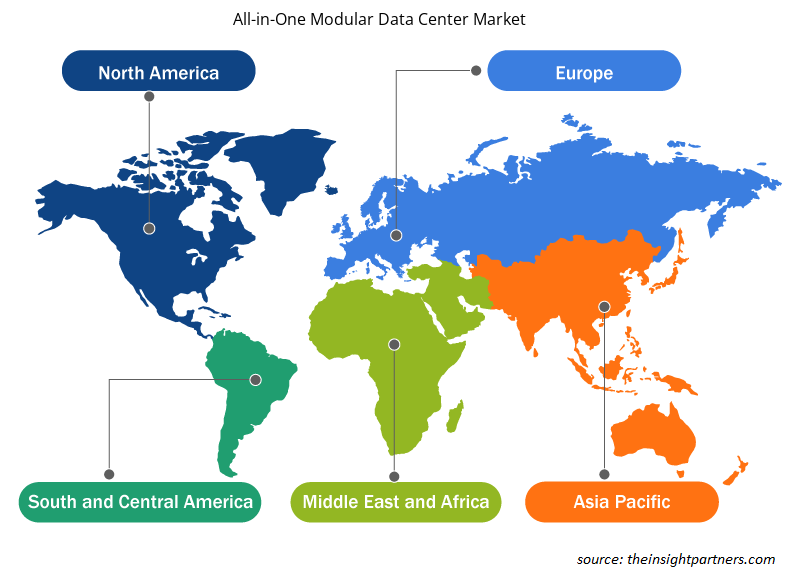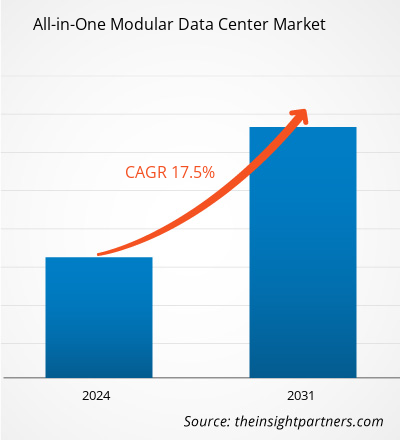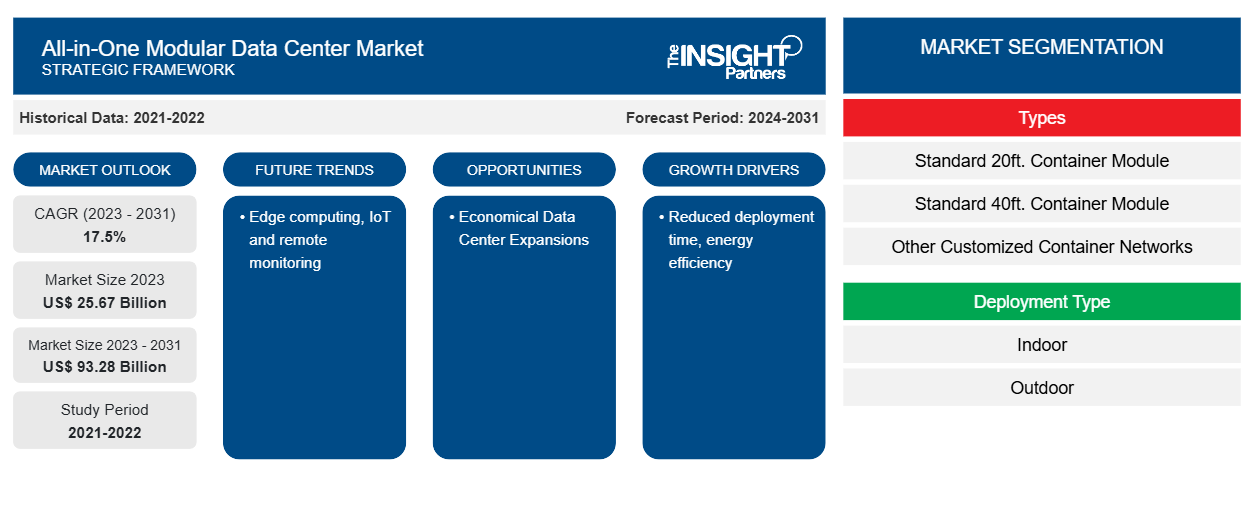Si prevede che la dimensione del mercato dei data center modulari All-in-One raggiungerà i 93,28 miliardi di dollari entro il 2031, rispetto ai 25,67 miliardi di dollari del 2023. Si prevede che il mercato registrerà un CAGR del 17,5% nel 2023-2031. Edge computing, IoT e monitoraggio remoto rimarranno probabilmente le principali tendenze del mercato dei data center modulari All-in-One.
Analisi di mercato dei data center modulari all-in-one
L'agilità è fondamentale quando le aziende cercano di accelerare l'innovazione e di rendere le loro operazioni a prova di futuro. La partecipazione all'economia digitale richiede l'accesso all'infrastruttura fisica a velocità software, altrimenti le aziende rischiano di perdere un vantaggio competitivo. I data center fisici sono spesso richiesti, sia che un'azienda operi in una regione metropolitana o in una posizione remota in un altro paese. Le aziende affronteranno delle sfide quando inizieranno a progettare e costruire nuove strutture, sia locali che lontane. Creare data center tradizionali da zero può essere pericoloso, costoso e richiedere molto tempo.
Panoramica del mercato dei data center modulari all-in-one
Date le sfide della costruzione di data center, non c'è da stupirsi che i provider di colocation e cloud, le aziende di telecomunicazioni e le organizzazioni stiano spostando le loro risorse verso data center modulari. Secondo un nuovo studio di Vertiv e OMDIA, il 93% degli intervistati ha affermato che avrebbe adottato soluzioni di data center modulari prefabbricati come procedura di costruzione predefinita.
Personalizza questo report in base alle tue esigenze
Riceverai la personalizzazione gratuita di qualsiasi report, comprese parti di questo report, o analisi a livello nazionale, pacchetto dati Excel, oltre a usufruire di grandi offerte e sconti per start-up e università
-
Scopri le principali tendenze di mercato in questo rapporto.Questo campione GRATUITO includerà analisi di dati che spaziano dalle tendenze di mercato alle stime e alle previsioni.
Driver e opportunità di mercato per i data center modulari all-in-one
Le industrie emergenti basate sui dati favoriscono il mercato
Il mondo odierno opera sui dati; si stima che ogni giorno vengano generati 2,5 quintilioni di byte di dati. Come risultato del flusso di dati, aziende, colocation, provider di servizi cloud e utenti aziendali si stanno affrettando a stabilire nuovi data center più efficienti. Ciò ha notevolmente aumentato la quantità di progetti di espansione dei data center e campus di data center iperscalabili in costruzione in tutto il mondo. Nonostante questo rapido sviluppo, molte organizzazioni trovano sempre più difficile completare le riprogettazioni dei data center nei tempi previsti e nel budget. Oltre alla scarsità di manodopera qualificata a livello nazionale, i metodi di costruzione tradizionali presentano una serie di altri problemi operativi, tra cui limiti di budget, ritardi nella costruzione, spreco di siti e altri impedimenti che causano l'estensione dei tempi di sviluppo. Un numero sempre maggiore di operatori di data center sta utilizzando la costruzione modulare per crescere rapidamente, gestire i costi e stabilire una base estensibile che possa adattarsi rapidamente alle nuove tecnologie.quintillion bytes of data are generated every day. As a result of the data flood, businesses, colocation, cloud service providers, and corporate users are rushing to establish new, more efficient data centers. This has significantly boosted the amount of hyperscale data center campuses being constructed throughout the world. Despite this rapid development, many organizations are finding it increasingly difficult to complete data center redesigns on schedule and under budget. In addition to the national skilled labor scarcity, traditional building methods present a number of other operational issues, including budget limits, construction delays, site waste, and other impediments that cause the development timeframe to be extended. More data center operators are using modular construction to grow swiftly, manage costs, and establish an extensible foundation that can adapt quickly to new technology.
Espansioni economiche del data center: un'opportunità nel data center modulare all-in-one
Secondo un sondaggio Omdia condotto nel primo trimestre del 2022, è probabile che gli investimenti in data center modulari aumentino, con il 99% degli intervistati che afferma che un data center modulare farà parte della loro futura strategia di data center e quasi la metà si aspetta che fino a un quarto dei loro carichi IT saranno fisicamente ubicati in data center modulari o containerizzati nel 2023. Il sondaggio ha anche scoperto che i data center modulari consentono espansioni e aggiornamenti, con il 43% degli intervistati che afferma che sono più adatti per estendere un data center esistente e il 39% che afferma che sono adatti per ristrutturazioni o retrofit.Omdia survey conducted in the first quarter of 2022, investment in modular data centers is likely to increase, with 99% of respondents stating that a modular data center will be part of their future data center strategy and nearly half expecting up to a quarter of their IT loads to be physically located at modular or containerized data centers in 2023. The survey also discovered that modular data centers permit expansion and updates, with 43% of respondents saying they're best suited for extending an existing data center and 39% saying they're good for renovations or retrofits.
Analisi della segmentazione del rapporto di mercato dei data center modulari all-in-one
I segmenti chiave che hanno contribuito alla derivazione dell'analisi di mercato dei data center modulari all-in-one sono i tipi di container personalizzati, i tipi di distribuzione e gli utenti finali.
- In base ai tipi di container personalizzati, il mercato dei data center modulari All-in-One è suddiviso in moduli container standard da 20 piedi, moduli container standard da 40 piedi e altri. Il segmento dei moduli container standard da 40 piedi ha detenuto la quota maggiore del mercato nel 2023.
- In base al tipo di distribuzione, il mercato dei data center modulari All-in-One è suddiviso in indoor e outdoor.
- In base all'utente finale, il mercato dei data center modulari All-in-One è suddiviso in BFSI, telecomunicazioni e IT, OTT, pubblica amministrazione e sanità.
Analisi della quota di mercato dei data center modulari all-in-one per area geografica
L'ambito geografico del rapporto di mercato sui data center modulari all-in-one è suddiviso principalmente in cinque regioni: Nord America, Asia Pacifico, Europa, Medio Oriente e Africa e Sud America/Sud e Centro America.
Il Nord America ha dominato ilMercato dei data center modulari All-in-One. Le esigenze aziendali in evoluzione della regione e la crescente domanda di data center modulari in Nord America stanno guidando la domanda di data center modulari All-in-One nella regione.
Approfondimenti regionali sul mercato dei data center modulari All-in-One
Le tendenze regionali e i fattori che influenzano il mercato dei data center modulari All-in-One durante il periodo di previsione sono stati ampiamente spiegati dagli analisti di Insight Partners. Questa sezione discute anche i segmenti e la geografia del mercato dei data center modulari All-in-One in Nord America, Europa, Asia Pacifico, Medio Oriente e Africa e America centrale e meridionale.

- Ottieni i dati specifici regionali per il mercato dei data center modulari all-in-one
Ambito del rapporto di mercato sui data center modulari all-in-one
| Attributo del report | Dettagli |
|---|---|
| Dimensioni del mercato nel 2023 | 25,67 miliardi di dollari USA |
| Dimensioni del mercato entro il 2031 | 93,28 miliardi di dollari USA |
| CAGR globale (2023-2031) | 17,5% |
| Dati storici | 2021-2022 |
| Periodo di previsione | 2024-2031 |
| Segmenti coperti |
Per tipi
|
| Regioni e Paesi coperti |
America del Nord
|
| Leader di mercato e profili aziendali chiave |
|
Attori del mercato dei data center modulari All-in-One Densità: comprendere il suo impatto sulle dinamiche aziendali
Il mercato dei data center modulari All-in-One sta crescendo rapidamente, spinto dalla crescente domanda degli utenti finali dovuta a fattori quali l'evoluzione delle preferenze dei consumatori, i progressi tecnologici e una maggiore consapevolezza dei vantaggi del prodotto. Con l'aumento della domanda, le aziende stanno ampliando le loro offerte, innovando per soddisfare le esigenze dei consumatori e capitalizzando sulle tendenze emergenti, il che alimenta ulteriormente la crescita del mercato.
La densità degli operatori di mercato si riferisce alla distribuzione di aziende o società che operano in un particolare mercato o settore. Indica quanti concorrenti (operatori di mercato) sono presenti in un dato spazio di mercato in relazione alle sue dimensioni o al valore di mercato totale.
Le principali aziende che operano nel mercato dei data center modulari All-in-One sono:
- Dell Inc.
- Sviluppo aziendale Hewlett Packard LP
- Società controllata da Huawei
- Gruppo Vertiv Corp.
- Mangiare
- Schneider elettrico
Disclaimer : le aziende elencate sopra non sono classificate secondo un ordine particolare.

- Ottieni una panoramica dei principali attori del mercato dei data center modulari All-in-One
Notizie di mercato e sviluppi recenti sui data center modulari All-in-One
Il mercato dei data center modulari All-in-One viene valutato raccogliendo dati qualitativi e quantitativi post-post-primari e secondari, che includono importanti pubblicazioni aziendali, dati associativi e database. Di seguito è riportato un elenco degli sviluppi nel mercato dei data center modulari All-in-One e delle strategie:
- Dell Technologies annuncia nuove soluzioni per aiutare i clienti ad adattarsi alla natura mutevole dei dati e ad acquisire il valore sensibile al tempo di miliardi di dispositivi all'edge al di fuori di un data center tradizionale. Con una serie di nuove offerte, tra cui nuovi design di server edge, data center modulari più piccoli, gestione della telemetria migliorata e un motore di analisi in streaming, i clienti sono meglio posizionati per realizzare il valore dei propri dati ovunque risiedano. (Fonte: Dell Inc, comunicato stampa, 2020)
Copertura e risultati del rapporto sul mercato dei data center modulari All-in-One
Il rapporto "Dimensioni e previsioni del mercato dei data center modulari all-in-one (2021-2031)" fornisce un'analisi dettagliata del mercato che copre le seguenti aree:
- Dimensioni e previsioni del mercato a livello globale, regionale e nazionale per tutti i segmenti di mercato chiave coperti dall'ambito
- Dinamiche di mercato come fattori trainanti, vincoli e opportunità chiave
- Principali tendenze future
- Analisi dettagliata delle cinque forze PEST/Porter e SWOT
- Analisi di mercato globale e regionale che copre le principali tendenze di mercato, i principali attori, le normative e gli sviluppi recenti del mercato
- Analisi del panorama industriale e della concorrenza che copre la concentrazione del mercato, l'analisi della mappa di calore, i principali attori e gli sviluppi recenti
- Profili aziendali dettagliati
- Analisi storica (2 anni), anno base, previsione (7 anni) con CAGR
- Analisi PEST e SWOT
- Valore/volume delle dimensioni del mercato - Globale, Regionale, Nazionale
- Industria e panorama competitivo
- Set di dati Excel
Report recenti
Rapporti correlati
Testimonianze
Motivo dell'acquisto
- Processo decisionale informato
- Comprensione delle dinamiche di mercato
- Analisi competitiva
- Analisi dei clienti
- Previsioni di mercato
- Mitigazione del rischio
- Pianificazione strategica
- Giustificazione degli investimenti
- Identificazione dei mercati emergenti
- Miglioramento delle strategie di marketing
- Aumento dell'efficienza operativa
- Allineamento alle tendenze normative























 Ottieni un campione gratuito per - Mercato dei data center modulari all-in-one
Ottieni un campione gratuito per - Mercato dei data center modulari all-in-one